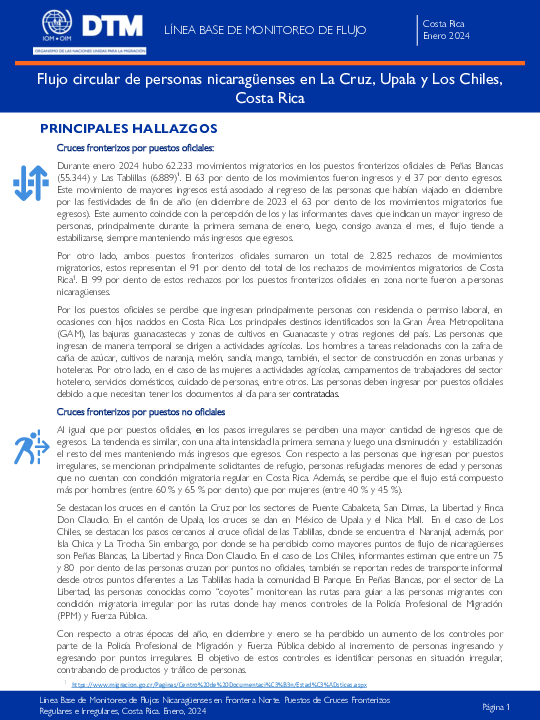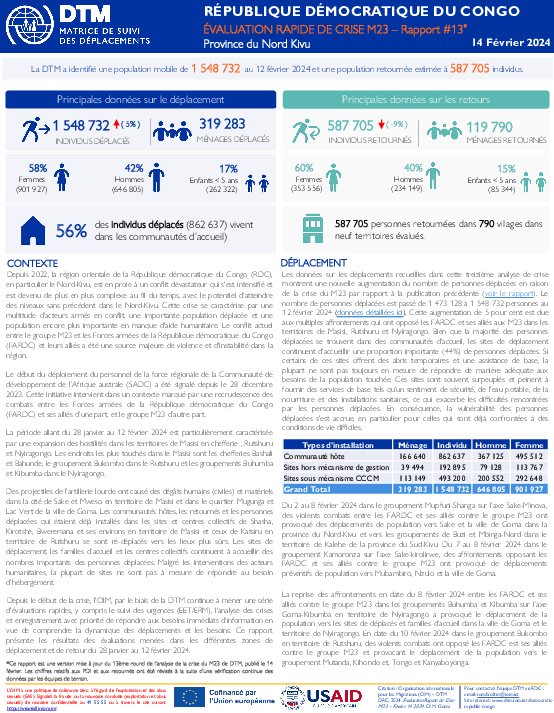-
Countries
-
Data and Analysis
-
Special Focus
-
Crisis Responses

Contact
Angélica Madrigal amadrigal@iom.int
Language
English
Location
Costa Rica
Period Covered
Jan 01 2024
Jan 30 2024
Activity
- Survey
- Registration
- Flow Monitoring
Cantones: Alajuela, Cartago, Corredores, Desamparados, Heredia, Liberia, Los Chiles, San Carlos, San José, Santa Ana y Tibás
Costa Rica, al igual que los demás países de la región centroamericana, se ha caracterizado por ser un corredor migratorio para personas que transitan de manera terrestre desde el sur hasta el norte de América y que tienen como destino los países del norte del continente. Este flujo en situación de movilidad por las Américas se encuentra compuesto principalmente por personas de la República Bolivariana de Venezuela, Cuba, Haití, Ecuador, así como personas provenientes de otros países de Suramérica, África y Asia.
Según estimaciones de la OIM Costa Rica, durante enero ingresaron al país 37.436 personas, un promedio aproximado de 1.208 personas por día y estimando un aumento de un 30% con respecto a diciembre de 2023. Además, se identificaron 1.407 personas varadas en los albergues monitoreados y 732 personas varadas en los sitios públicos visitados.

Contact
DTMUkraine@iom.int
Language
English
Location
Ukraine
Period Covered
Jan 01 2024
Jan 31 2024
Activity
- Baseline Assessment
The Registered IDP Area Baseline Assessment provides granular data on the number and geographic location of officially registered internally displaced people (IDPs). This report assesses registered IDP presence at the raion level, also mapping the recorded change since the previous round. Round 32 presents the data of the registered IDP population disaggregated by sex, age and state-recognised disability status.
The data collected for the Area Baseline Assessment Round 32 reflects the up-to-date local administrative register of the IDP population as of 31 January 2024, equivalent to a total of 3,509,147 registered IDPs. Registered IDP figures were collected for 1,098 hromadas (83% of all hromadas covered in Ukrainian government-controlled areas), across 108 raions and 23 oblasts. Data disaggregated by age, sex and disability status were provided for around 83 per cent of the administrative units covered.

Contact
DTMCostaRica@iom.int
Language
English
Location
Costa Rica
Period Covered
Jan 01 2024
Jan 31 2024
Activity
- Flow Monitoring
- Baseline Assessment
La Organización Internacional para las Migraciones (OIM), como agencia de las Naciones Unidas en materia de migración en Costa Rica, implementó, desde 2021, dos rondas de la Matriz de Seguimiento al Desplazamiento (DTM por sus siglas en inglés) como parte de su estrategia de monitoreo del flujo migratorio circular de personas de nacionalidad nicaragüense, en puntos fronterizos no oficiales, en distintos cantones del norte del país. A partir de este ejercicio en tres puntos de ingreso no oficial de la frontera con Nicaragua, se contabilizaron 60 697 movimientos migratorios, de los cuales el 59 por ciento fueron egresos y 41 por ciento ingresos.
Siendo parte fundamental de la misión de OIM brindar asesoría clave sobre políticas y prácticas migratorias, se vuelve necesario actualizar los datos de este flujo migratorio circular de nicaragüenses que cruzan tanto de forma regular como irregular la frontera norte de Costa Rica.
Según los registros de la DGME de ingresos y egresos regulares por puestos fronterizos oficiales en Los Chiles y Peñas Blancas, en 2022 hubo 394.730 movimientos migratorios regulares (50 % ingresos y 50 % egresos). Durante el 2023, en total se registraron 526.271 movimientos migratorios (50 % ingresos y 50 % egresos) . Los movimientos migratorios de 2023 superaron en un 33,3 por ciento los de 2022. Durante enero del 2024, se han realizado un total de 62.233 movimientos migratorios siendo el 63 por ciento ingresos y el 37 por ciento egresos.

Contact
dtmlebanon@iom.int
Language
English
Location
Lebanon
Period Covered
Oct 10 2023
Feb 13 2024
Activity
- Mobility Tracking
- Baseline Assessment
Since October 8 there has been an increase in cross-border incidents between Israel and Lebanon, resulting in the displacement of people both within the South and elsewhere within the country. Since October 10, the Displacement Tracking Matrix (DTM) has been conducting the daily monitoring of population movements. The objective of the exercise is to inform preparedness and response planning.

Contact
DTMMozambique@iom.int
Language
English
Location
Mozambique
Period Covered
Feb 08 2024
Feb 14 2024
Activity
- Mobility Tracking
- Event Tracking
Between 22 December to 12 February, a series of sporadic attacks and fear of attacks by Non-state Armed Groups in Macomia, Chiure, Mecufi, Mocimboa da Praia, and Muidumbe triggered the cumulative displacement 12,963 individuals/2,047 families.
Although included within this cumulative displacement estimate- the current Movement Alert #97 reports on recent attacks recorded in Macomia, Chiure and Mecufi between 8 to 14 February that displaced 2,114 individuals. Within this reporting period, arrivals of displaced families have been mapped across villages of Ancuabe, Macomia, Chiure, Muidumbe, Quissanga, Metuge, Montepuez, Mecufi, Erati and Ibo.
Of the total individuals displaced between 8-14 February, 128 families with 348 individuals have taken refuge in displacement centers of Macomia (Nanga A and Nanga B), 190 families with 676 individuals have taken refuge in displacement centers of Chiure (Maningane, Muajaja, and Namisir), 15 families with 64 individuals have taken refuge in displacement centers of Montepuez (Ntele), 17 families with 68 individuals have taken refuge in displacement centers of Metuge (Ngunga), 2 families with 16 individuals have taken refuge in displacement centers of Mueda (Lyanda) and 3 families with 8 individuals have taken refuge in displacement centers of Ancuabe (Cujupane, Nanjua).
Contact
dtmlebanon@iom.int
Location
Lebanon
Activity
- Mobility Tracking
- Baseline Assessment
Period Covered
Oct 10 2023 -Feb 06 2024
Since October 8 there has been an increase in cross-border incidents between Israel and Lebanon, resulting in the displacement of people both within the South and elsewhere within the country. Since October 10, the Displacement Tracking Matrix (DTM) has been conducting the daily monitoring of population movements. The objective of the exercise is to inform preparedness and response planning.
Population Groups
IDPs
Survey Methodology
Unit of Analysis Or Observation
Admin Area 2
Admin Area 3
Type of Survey or Assessment
Key Informant
Keywords
Geographical Scope Full Coverage
Administrative boundaries with available data
The current dataset covers the following administrative boundaries

Contact
DTMAfghanistan@iom.int
Language
English
Location
Afghanistan
Period Covered
Feb 04 2024
Feb 10 2024
Activity
- Survey
- Flow Monitoring Survey
- Flow Monitoring
In response to recent movements, IOM Afghanistan re-launched its DTM Flow Monitoring activity at the beginning of 2024 to better understand the mobility dynamics at Afghanistan’s borders. Since 10 January 2024, DTM has deployed field teams at four border crossing points with the Islamic Republic of Iran (IRN) and Pakistan (PAK) (see map below) to conduct two interlinked exercises. The first is a headcount of all individuals entering or leaving Afghanistan (including returnees), also called Flow Monitoring Counting (FMC), to gauge flow volume. The second is a survey of randomly selected Afghan national individuals or groups entering or leaving Afghanistan, also called the Flow Monitoring Survey (FMS), to understand the profiles, motivations, and vulnerabilities of the target population. This snapshot provides key findings combining various IOM data sources, including DTM Afghanistan’s FMC and FMS activities, DTM Pakistan’s Flow Monitoring of Afghan returnees, and IOM Afghanistan’s Cross-Border Post-Arrival Humanitarian Assistance (CB-PAHA) program, for the period 4 to 10 February 2024. For more information about methodology, see the the section in the last page of this report titled “IOM INFLOWS.”

Contact
DTM DRC, iomdrcdtm@iom.int
Language
French
Location
Democratic Republic of the Congo
Period Covered
Jan 28 2024
Feb 12 2024
Activity
- Mobility Tracking
- Event Tracking
Depuis 2022, la région orientale de la République démocratique du Congo (RDC), en particulier le Nord-Kivu, est en proie à un conflit dévastateur qui s'est intensifié et est devenu de plus en plus complexe au fil du temps, avec le potentiel d'atteindre des niveaux sans précédent dans le Nord-Kivu. Cette crise se caractérise par une multitude d'acteurs armés en conflit, une importante population déplacée et une population encore plus importante en manque d'aide humanitaire. Le conflit actuel entre le groupe M23 et les Forces armées de la République démocratique du Congo (FARDC) et leurs alliés a été une source majeure de violence et d'instabilité dans la région.
La période allant du 28 janvier au 12 février 2024 est particulièrement caractérisée par une expansion des hostilités dans les territoires de Masisi en chefferie , Rutshuru et Nyiragongo. Les endroits les plus touchés dans le Masisi sont les chefferies Bashali et Bahunde, le groupement Bukombo dans le Rutshuru et les groupements Buhumba et Kibumba dans le Nyiragongo.
Depuis le début de la crise, l'OIM, par le biais de la DTM continue à mener une série d'évaluations rapides, y compris le suivi des urgences (EET/ERM), l'analyse des crises et enregistrement avec priorité de répondre aux besoins immédiats d'information en vue de comprendre la dynamique des déplacements et les besoins. Ce rapport présente les résultats des évaluations menées dans les différentes zones de déplacement et de retour du 28 janvier au 12 février 2024.

Contact
DTM DRC, iomdrcdtm@iom.int
Language
English
Location
Democratic Republic of the Congo
Period Covered
Jan 28 2024
Feb 12 2024
Activity
- Mobility Tracking
- Event Tracking
Since 2022, the eastern region of the Democratic Republic of Congo (DRC), in particular North Kivu, has been gripped by a devastating conflict that has intensified and become increasingly complex over time, with the potential to reach unprecedented levels in the province.
The period from 28 January to 12 February 2024 was particularly marked by an expansion of hostilities in the territories of Masisi, Rutshuru and Nyiragongo. The most affected areas identified are located in Masisi (the Bashali and Bahunde chefferies), the Bukombo groupement in Rutshuru and the Buhumba and Kibumba groupement in Nyiragongo.
Since the beginning of the crisis, IOM, through its Displacement Tracking Matrix (DTM), has continued conducting a series of rapid assessments, including emergency monitoring (EET/ERM), crisis analysis and registration with the aim of responding to immediate information needs in order to understand displacement dynamics.
This report presents the results of assessments carried out in the various displacement and return areas between 28 January and 12 February 2024.

Contact
DTM Ethiopia, DTMEthiopia@iom.int
Language
English
Location
Ethiopia
Period Covered
Aug 01 2023
Sep 02 2023
Activity
- Mobility Tracking
- Site Assessment
- Village Assessment
Between August and September 2023, the International Organization for Migration (IOM) Data and Research Unit (DRU), through its Displacement Tracking Matrix (DTM) methodology, deployed the Site Assessment(SA) and Village Assessment Survey (VAS) tools to assess the mobility, needs and vulnerabilities of Internally Displaced Persons (IDPs) and returning IDPs across Ethiopia.
This snapshot report will present key findings on needs and vulnerabilities, and will focus on Shelter and Non-Food Items (NFIs) in the locations assessed through the SA and VAS survey tools.
According to data collected, living conditions of IDPs in the assessed sites continue to be inadequate and unsafe. In 42.10% of assessed sites, no HHs were living in individual HH shelters. Furthermore, in 60.77% of sites there was no lighting in communal spaces and in 36.08% there was lighting but it was not adequate.